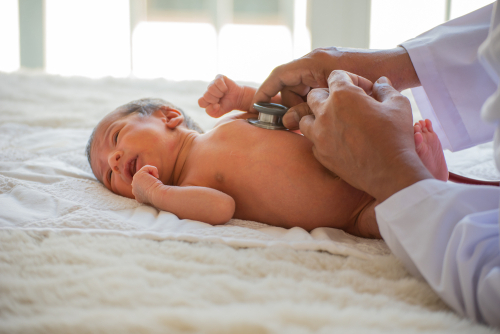SMA HCP News November Round-up: Risdiplam, Early Treatment, NURTURE Study

While the biggest news this week may be the success of the drug risdiplam in improving motor function in a late stage clinical trial on patients with SMA types 2 and 3,1 other important data on SMA have also been published in recent weeks.
Below is a roundup of new information on SMA.
Understanding SMA
Low-Intensity Running and High-Intensity Swimming Exercises Differentially Improve Energy Metabolism in Mice With Mild Spinal Muscular Atrophy.2
Based on evidence suggesting that energy metabolism is altered in those with SMA, the authors of this study investigated whether exercise could provide benefits related to metabolic status in a preclinical model of SMA. They found that active physical exercise, and particularly high-intensity workouts, led to improvements at cellular and systemic levels. They discuss implications for clinical care of SMA patients.
Read more here.
Interaction of Axonal Chondrolectin with Collagen XIXa1 Is Necessary for Precise Neuromuscular Junction Formation.3
Chondrolection is a membrane protein that is critical for motor axon extension in zebrafish. It has been shown to be dysregulated in mouse models of SMA. In this article, the authors describe a zebrafish and mouse study into the mechanisms by which chondrolectin functions. Their data reveal a role for this protein in synaptogenesis.
Read more here.
Neurofilament Heavy Chain and Tau Protein Are Not Elevated in Cerebrospinal Fluid of Adult Patients with Spinal Muscular Atrophy during Loading with Nusinersen.4
This article describes a study into potential biomarkers for motor neuron destruction in patients with SMA type 3. The authors looked at levels of neurofilament heavy chain, tau protein, and S100B protein in blood samples and cerebrospinal fluid at baseline and during nusinersen loading but did not find that these levels differed significantly across conditions. They therefore concluded that the slow rate of progression of SMA type 3 may prevent these potential markers of axonal degradation from elevating to a detectable level.
Read more here.
Spinal Muscular Atrophy (SMA) Subtype Concordance in Siblings: Findings From the Cure SMA Cohort.5
This paper describes a study into SMA subtype concordance amongst siblings, which has not been intensively investigated in the past. Researchers looked at sibling data from the Cure SMA database to identify diagnoses between 1996 and 2016. The researchers’ analysis showed that most siblings had the same SMA subtype, with SMA type 1 concordance being the most common form of concordance. The data did not reveal any relationship between sibling sex and concordance.
Read more here.
Treating SMA
Clinical Evidence Supporting Early Treatment Of Patients With Spinal Muscular Atrophy: Current Perspectives.6
This review covers evidence that early therapeutic intervention in patients with SMA improves long-term outcomes. According to the authors, recent innovations in SMA treatments have significantly changed prognosis for patients. They argue, however, that the only factor that has been shown to successfully predict the success of treatment is the age of the patient when the treatment is initiated. The authors therefore suggest that early treatment tends to be warranted.
Read more here.
Structural basis of a small molecule targeting RNA for a specific splicing correction.7
In this article, the authors describe their study into how a small molecule can achieve gene-specific alternative splicing corrections that have an important role in the treatment of SMA. Their data allowed them to identify a concept that they have coined 5’ splice site bulge repair.
Read more here.
Methods for Correction of the Single-Nucleotide Substitution c.840C>T in Exon 7 of the SMN2 Gene.8
This article addresses the challenge of intrathecal delivery of nusinersen in SMA patients with spinal deformities as well as those who have undergone surgical correction for scoliosis. The researchers used CT-guidance to deliver nusinersen with a transforaminal approach in 7 patients and the conventional interlaminar approach in 5 patients. All but 47 injections were successful. However, while the conventional approach was associated with only 1 adverse event, the transforaminal approach led to 4 adverse events, 1 of which was a subarachnoid hemorrhage. The researchers conclude that the transforaminal approach is therefore feasible for the delivery of nusinersen but could potentially lead to serious adverse events.
Read the letter here.
Nusinersen initiated in infants during the presymptomatic stage of spinal muscular atrophy: Interim efficacy and safety results from the Phase 2 NURTURE study.9
This article describes efficacy and safety outcomes of 25 children who were genetically diagnosed with SMA and began receiving nusinersen while they were infants and pre-symptomatic. At the time of follow up, the median of which was 2.9 years, all children were able to sit without support, and 22 of the 25 children could walk without assistance. The authors conclude that these data point to the importance of proactively treating those who are genetically diagnosed with SMA.
Read the letter here.
Recent Review:
- Advances in Treatment of Spinal Muscular Atrophy – New Phenotypes, New Challenges, New Implications for Care.10
The authors of this review cover emerging therapies for SMA and discuss the way that new treatment options have modified the natural course of the disease, leading to new phenotypes. They highlight developing clinical care challenges and the need for ongoing real-world data to improve clinical decision making.
Read more here.
Managing SMA
Presentation and management patterns of lower urinary tract symptoms in adults due to rare inherited neuromuscular diseases.11
This article describes a study into the urological manifestations of congenital neuromuscular conditions such as SMA. According to the results, these conditions can cause symptoms related to the lower urinary tract. The authors discuss specific clinical features of these symptoms and how to best manage them.
Read more here.
Long-Term Mechanical Insufflation-Exsufflation Cough Assistance in Neuromuscular Disease: Patterns of Use and Lessons for Application.12
This article describes a study investigating the impacts of non-invasive ventilation used in SMA children who have sleep-disordered breathing. Based on their analysis of 17 cases, the authors concluded that this treatment strategy is not only efficient but may also minimize respiratory tract infection incidence in SMA children.
Read more here.
References
1. Roche drug for spinal muscular atrophy hits target in late-stage trial. Reuters. https://www.reuters.com/article/us-roche-risdiplam-approval/roche-drug-for-spinal-muscular-atrophy-hits-target-in-late-stage-trial-idUSKBN1XL1WL. Published 2019. Accessed November 11, 2019.
2. Houdebine L, D’Amico D, Bastin J, et al. Low-Intensity Running and High-Intensity Swimming Exercises Differentially Improve Energy Metabolism in Mice With Mild Spinal Muscular Atrophy. Front Physiol. 2019;10:1258. doi:10.3389/fphys.2019.01258
3. Oprisoreanu A-M, Smith HL, Arya S, et al. Interaction of Axonal Chondrolectin with Collagen XIXa1 Is Necessary for Precise Neuromuscular Junction Formation. Cell Rep. 2019;29(5):1082-1098.e10. doi:10.1016/j.celrep.2019.09.033
4. Totzeck A, Stolte B, Kizina K, et al. Neurofilament Heavy Chain and Tau Protein Are Not Elevated in Cerebrospinal Fluid of Adult Patients with Spinal Muscular Atrophy during Loading with Nusinersen. Int J Mol Sci. 2019;20(21). doi:10.3390/ijms20215397
5. Jones CC, Cook SF, Jarecki J, et al. Spinal Muscular Atrophy (SMA) Subtype Concordance in Siblings: Findings From the Cure SMA Cohort. J Neuromuscul Dis. November 2019. doi:10.3233/JND-190399
6. Dangouloff T, Servais L. Clinical Evidence Supporting Early Treatment Of Patients With Spinal Muscular Atrophy: Current Perspectives. Ther Clin Risk Manag. 2019;15:1153-1161. doi:10.2147/TCRM.S172291
7. Campagne S, Boigner S, Rudisser S, et al. Structural basis of a small molecule targeting RNA for a specific splicing correction. Nat Chem Biol. October 2019. doi:10.1038/s41589-019-0384-5
8. Valetdinova KR, Ovechkina VS, Zakian SM. Methods for Correction of the Single-Nucleotide Substitution c.840C>T in Exon 7 of the SMN2 Gene. Biochemistry (Mosc). 2019;84(9):1074-1084. doi:10.1134/S0006297919090104
9. De Vivo DC, Bertini E, Swoboda KJ, et al. Nusinersen initiated in infants during the presymptomatic stage of spinal muscular atrophy: Interim efficacy and safety results from the Phase 2 NURTURE study. Neuromuscul Disord. September 2019. doi:10.1016/j.nmd.2019.09.007
10. Schorling DC, Pechmann A, Kirschner J. Advances in Treatment of Spinal Muscular Atrophy – New Phenotypes, New Challenges, New Implications for Care. J Neuromuscul Dis. November 2019. doi:10.3233/JND-190424
11. Roth JD, Pariser JJ, Stout TE, Misseri R, Elliott SP. Presentation and management patterns of lower urinary tract symptoms in adults due to rare inherited neuromuscular diseases. Urology. October 2019. doi:10.1016/j.urology.2019.09.039
12. Chatwin M, Simonds AK. Long-Term Mechanical Insufflation-Exsufflation Cough Assistance in Neuromuscular Disease: Patterns of Use and Lessons for Application. Respir Care. November 2019. doi:10.4187/respcare.06882



